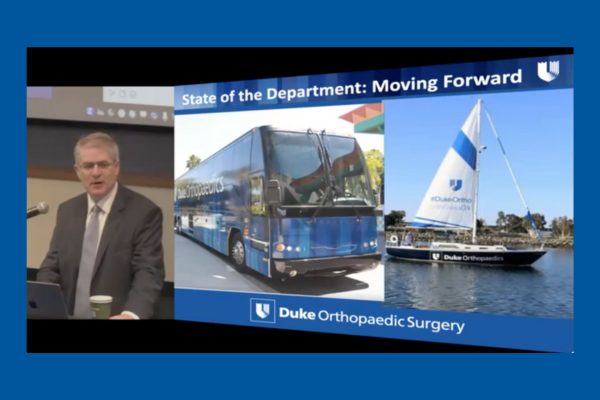
The Duke Department of Orthopaedic Surgery experienced a fantastic past year. Still, the future looks even brighter, Chair Benjamin Alman, MD, reported today at the Annual State of the Department event.
“Our department has had an excellent past year, and we are going to have an even better year going forward,” said Dr. Alman told attendees who joined online and in person at the Interprofessional Education and Care Building (IPE).
Last year’s theme for the Annual State of the Department was Stronger Together, as broad goals centered on working more closely across departments, learning from each other, and the large-scale effort to adopt the Duke Health Integrated Practice model.
Moving forward, Dr. Alman said, Duke Orthopaedics will pursue three key clinical areas of focus:
- How can we provide the best care for populations?
- How do we improve cost efficiency and effectiveness?
- Innovations in research and patient care
Over the next year, department leaders will update the strategic plan, which was last revised in 2018.
“As we refresh the strategic plan, I want us to be a department that focuses on eudaimonia,” said Dr. Alman, noting that he’s spoken in the past about how work brings people joy and satisfaction through watching students learn, treating a patient who has a great outcome, or proving a research hypothesis.
“But eudaimonia is one level above that,” he said, noting its origins in Greek philosophy.
“It’s the state or condition of good spirit. It’s different than happiness and joy because it focuses on the things you can control. It takes responsibility for what you are doing, to live with virtue and focus on the things that make a difference,” he said.
In startup businesses, eudaimonia among employees can lead to profitability. It’s also been linked to more robust student performance and improved patient outcomes, he explained.
Dr. Alman said that to strive for eudaimonia, the department will continue its efforts to improve communications, enhance culture, build community, and tackle brutal policies and bureaucracy.
Overall, Duke Orthopaedics’ research enterprise continues to thrive.
“We are continuing to do well. We have been ranked number one (as an Orthopaedics department) for National Institute of Health (NIH) funding*,” he said. He added that non-NIH funding and annual publications by researchers continue to rise.
Over the last decade, the department’s clinical activity has risen yearly, as measured by wRUs (work relative value units), except for 2020 due to COVID-19. Duke Ortho’s clinical care is provided by 13 clinics across the region.
The department is also thriving as one of the largest educational program providers, with more than 500 learners, which includes residents, fellows, and students enrolled in the Occupational Therapy Doctorate and Physical Therapy Doctorate programs.
“All of these are exceptional programs, and we have great leaders who focus on education,” said Dr. Alman.
Over the next year, the department will look to build and enhance partnerships that help achieve shared goals. He mentioned collaborations with the Margolis Center for Health Policy, Duke AI Health, Duke Clinical Research Institute (DCRI), among other departments, schools, and institutes.
He noted that the department’s performance is directly tied to its faculty, staff, and students.
“This is all about you and members of our department. The reason our department is so strong and doing so well and we have such a bright future is because of the members of our department,” he said.